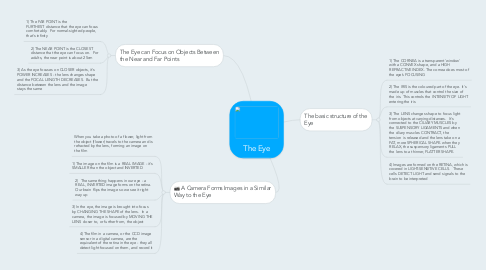The Eye
by Erin O

1. The basic structure of the Eye
1.1. 1) The CORNEA is a transparent 'window' with a CONVEX shape, and a HIGH REFRACTIVE INDEX. The cornea does most of the eye's FOCUSING
1.2. 2) The IRIS is the coloured part of the eye. It's made up of muscles that control the size of the iris. This controls the INTENSITY OF LIGHT entering the iris
1.3. 3) The LENS changes shape to focus light from objects at varying distances. It's connected to the CILIARY MUSCLES by the SUSPENSORY LIGAMENTS and when the ciliary muscles CONTRACT, the tension is released and the lens take on a FAT, more SPHERICAL SHAPE. when they RELAX, the suspensory ligaments PULL the lens to a thinner, FLATTER SHAPE.
1.4. 4) Images are formed on the RETINA, which is covered in LIGHT-SENSITIVE CELLS. These cells DETECT LIGHT and send signals to the brain to be interpreted
2. The Eye can Focus on Objects Between the Near and Far Points
2.1. 1) The FAR POINT is the FURTHEST distance that the eye can focus comfortably. For normal-sighted people, that's infinity
2.2. 2) The NEAR POINT is the CLOSEST distance that the eye can focus on. For adults, the near point is about 25cm
2.3. 3) As the eye focuses on CLOSER objects, it's POWER INCREASES - the lens changes shape and the FOCAL LENGTH DECREASES. But the distance between the lens and the image stays the same
3. A Camera Forms Images in a Similar Way to the Eye
3.1. When you take a photo of a flower, light from the object (flower) travels to the camera and is refracted by the lens, forming an image on the film
3.2. 1) The image on the film is a REAL IMAGE - it's SMALLER than the object and INVERTED
3.3. 2) The same thing happens in our eye - a REAL, INVERTED image forms on the retina. Our brain flips the image so we see it right way up
3.4. 3) In the eye, the image is brought into focus by CHANGING THE SHAPE of the lens. In a camera, the image is focused by MOVING THE LENS closer to, or further from, the object
3.5. 4) The film in a camera, or the CCD image sensor in a digital camera, are the equivalent of the retina in the eye - they all detect light focused on them, and record it


